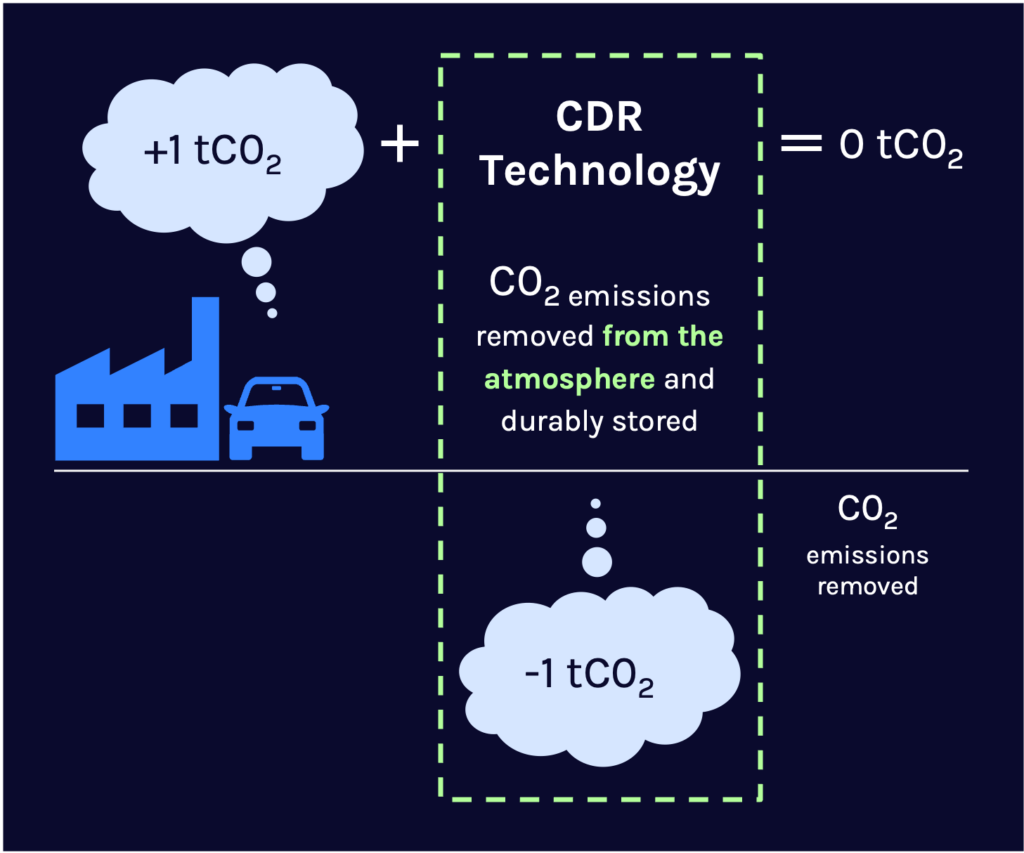Clearing the Air: Understanding Carbon Dioxide Removal
With companies setting net-zero targets and countries working to achieve their climate goals under the Paris Agreement, there’s been much discussion lately about the role of emission reductions and carbon removals. There is overwhelming scientific consensus that carbon dioxide removal (CDR) is necessary to achieving our collective goal of limiting global warming to 1.5°C above pre-Industrial levels. But what exactly is CDR and how can it meaningfully help us to address climate change? To understand the importance of CDR, you have to first consider the larger picture.
Since the Industrial Revolution, humans have increasingly added carbon dioxide to the atmosphere as the result of fuel combustion, land use change, and other practices of our modern world. This has caused significant amounts of carbon dioxide to accumulate in our atmosphere — with the latest measurement from NASA indicating 425 parts per million (PPM) of carbon dioxide (CO2). Emitted carbon dioxide remains in the atmosphere for hundreds of years, trapping heat and preventing it from leaving. Subsequently, the warming effect compounds over the carbon dioxide’s lifetime in the atmosphere, leading to rising global temperatures and other climate impacts — many of which we are experiencing across the globe with increasing frequency and severity.
The Role of Carbon Dioxide Removal
The 10 warmest years since 1850 have all occurred in this past decade, with 2023 being the warmest on record. In order to combat this trend and meet global climate targets, we need to reduce the total amount of carbon dioxide in the atmosphere. Plain and simple. One way to achieve this goal is by reducing the amount of new emissions we are releasing into the atmosphere on a daily basis. This approach, although impactful, is easier said than done, as many companies and individuals among us are not willing to sacrifice the modern day conveniences that drive these emissions. So what are we to do?
This is where CDR comes into play. CDR technologies remove carbon dioxide directly from the atmosphere and durably store it for significant periods of time (e.g., decades to millennia) so that the CO2 cannot continue to exacerbate climate change. In this way, CDR enables us to: 1) address historical emissions that have accumulated in the atmosphere; 2) reduce hard-to-abate emissions from everyday activities that cannot be eliminated through emission reductions alone; and 3) achieve the slowdown — and potential reversal — of climate change impacts by drawing down the total amount (or PPM) of CO2 in the atmosphere (see Image 1). This is why CDR is critical in the fight against climate change.
Image 1. The Impact of CDR Technologies
CDR solutions remove existing carbon dioxide from the atmosphere and durably store it for significant periods of time so that it can no longer cause climatic damage. In this example, the net impact of the CDR technology is the removal of 1 metric ton of carbon dioxide (tCO2) from the atmosphere.

Carbon Dioxide Removal Pathways
Given the nascency of the CDR space and the urgency of the climate crisis, it is critical to support and scale a large and diverse set of innovative carbon removal solutions and to do so as quickly as possible. To this end, Climate Vault rigorously evaluates CDR solutions across three pathways through its annual RFP process. This process identifies the highest quality and most impactful solutions available. The three pathways we look at are:
- Terrestrial: Solutions that use the natural processes and capabilities of plants, soil, and microorganisms to sequester and store carbon out of the atmosphere. Examples of projects include: enhanced weathering, soil carbon sequestration, plant cultivars and no-till agriculture practices.
- Technological: Engineered solutions that remove and sequester carbon from the atmosphere, including fully-engineered solutions, as well as solutions that enhance natural carbon removal and sequestration processes with the assistance of engineered components. Examples of projects include direct air capture with carbon storage (DACCS), bio-energy with carbon capture and storage (BECCS), and biochar.
- Oceanic: Solutions that use the ocean’s natural function as a carbon sink and enhance the carbon sequestration capabilities of critical marine ecosystems. Examples of projects include ocean alkalinity enhancement (OAE); macroalgae growth, harvesting and sequestration; and blue carbon, which includes the restoration and sustainable management of coastal and marine ecosystems, such as tidal marshes, mangroves and seagrasses.
To learn more about Climate Vault’s three CDR pathways and to meet the first 10 CDR innovators who applied for Climate Vault’s 2023 RFP round, check out our on-demand webinar series.
Verified Carbon Dioxide Removal Innovation — Today
To borrow a common refrain, when it comes to CDR, we need “everything, everywhere, all at once” in order to achieve gigatonne-scale carbon removal and to have a chance to avoid the most catastrophic impacts of climate change. With innovative CDR technologies, these goals are within our grasp. However, it will take continued effort, unwavering support by stakeholders across the environmental markets, and strict high-quality standards to achieve this impact.
At Climate Vault, we are using the power of the markets to leverage emission reductions into ultimate carbon removal. By enabling the accelerated growth of these crucial technologies, we can drive significant impact in the fight against climate change — for each other and for our planet.
To learn more about how you and your company can get involved with supporting high-quality and innovative CDR solutions, reach out to the team here at Climate Vault.
